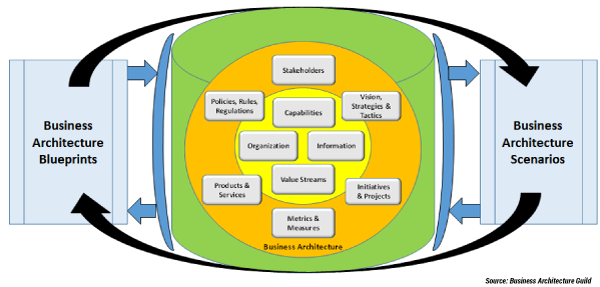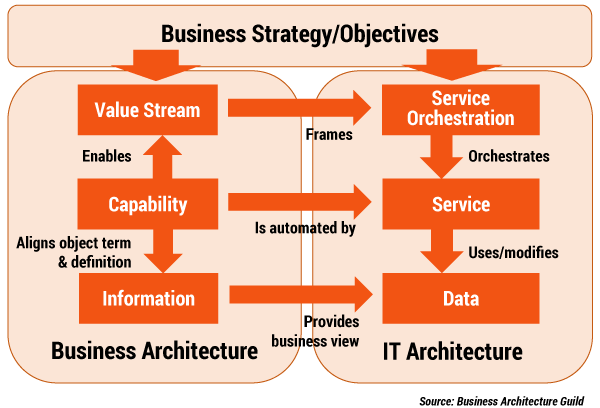B & EA EXECUTIVE UPDATE VOL. 20, NO. 12

This is the fourth installment of an Executive Update series on business architecture. The first Update considered business architecture’s role in crisis, risk, and compliance management, positioning business architecture as an essential management discipline for addressing external and internal challenges and disruptions. Installments two and three by Cutter Senior Consultant Whynde Kuehn discussed leveraging business architecture to drive and deploy innovation and digital transformation, positioning business architecture as a proactive enabler of critical business priorities. This final Update peers into the future, considering business architecture’s foundational role in establishing the cognitive enterprise.
What Is the Cognitive Enterprise?
The “cognitive enterprise” describes a business that learns, adapts, and scales on an evolutionary basis. The cognitive enterprise must have a deep and expansive understanding of its capabilities, internal and external stakeholders, stakeholder value proposition, and the ecosystem in which it operates. Cognitive enterprise scenarios can touch many other impact points across a business ecosystem, extending well into partner and customer domains. Imagine, for example, the following scenarios that may manifest within a cognitive enterprise:
-
Customer preferences derived through a point of engagement within one division, account, inquiry, or product purchase are automatically reflected and integrated for that customer across all business units and product lines.
-
A virtual product manager conceptualizes and designs a new and unique product that automatically considers and aggregates related products that share similar capabilities, reframing entire product suites in the process.
-
A virtual program manager identifies cross-project impacts and conflicts by leveraging a comprehensive understanding of proposed and inflight projects across business units, producing an optimized set of programs and projects, sequenced based on strategic priorities and overall interdependencies.
The technological foundation for the cognitive enterprise involves the concept of “cognitive computing.” In his book Cognitive Computing, Peter Fingar states that “cognitive computing systems learn and interact naturally with people to extend what either humans or machines could do on their own.” He provides vivid examples of how this cognitive shift is already underway and keen insights as to where businesses are headed in the not-too-distant future. Cognitive computing concepts may be applied to a business ecosystem in aggregate, framing the underlying technology foundation for the cognitive enterprise.
Applying cognitive computing to a business ecosystem is by no means far-fetched, with the concept of the cognitive enterprise evolving in theory and practice. In her book Serious Games for Business, along with an Update, Phaedra Boinodiris discusses using gamification, which applies elements of game playing to other disciplines and activities to more fully engage customers, employees, and partners. Coupling cognitive computing with game theory, including simulations, advances key elements for transforming businesses into a cognitive enterprise. But alone, these concepts are not enough.
Becoming a Cognitive Enterprise: The Transformative Journey Ahead
As exciting as these ideas sound, the concept of the cognitive enterprise remains out of reach for many businesses today. Most organizations are ill prepared to jump into this advanced realm of cognitive self-awareness because basic understandings of core business concepts, including cross-business capabilities, vocabulary, and stakeholder value delivery, are at best opaque and, at worst, represent the “unknown unknowns” on many levels.
As pointed out in the first Update of this series, today’s organizations find it difficult to define — let alone locate — all instances of and interrelations across customers, accounts, agreements, assets, and other critical business perspectives. Comparing and contrasting the lack of organizational self-awareness described in the crisis management Update with the aforementioned cognitive enterprise scenarios highlights the long journey ahead for most businesses aspiring to a higher degree of cognitive self-awareness.
In other words, the ability to organizationally deploy and scale the scenarios proffered at the beginning of this Update is beyond the reach of the average business because most organizations lack a viable foundation for establishing a learning, evolving cognitive enterprise. The basic building blocks are missing from the puzzle. Yet some may argue that good technology is enough to transform a business into a cognitive enterprise.
Let us work under the assumption that an organization adopts and optimizes a cognitive computing environment that learns, adapts, and engages the automation concepts currently available and continuing to evolve. These technologies are described in works by Fingar and Senior Consultant Curt Hall, who says that “cognitive computing refers to a class of systems that can learn at scale, reason, and interface with humans in a manner more in tune with the way people interact with one another.” The underlying technologies and related design concepts that bring cognitive computing into reality include artificial intelligence (AI), rules-based solutions, neural networks, predictive analytics, and more traditional and emerging options.
This partial list of smart technologies is expanding and maturing, meaning that the technology needed to enable cognitive computing is ready to be leveraged by organizations in the position to do so. Of course, most businesses rely on a vast installed base of legacy systems that represent the antithesis of the aforementioned cognitive computing solutions. Legacy systems paint an opaque picture of a business, where tracing basic business perspectives across business units and divisions is time-consuming, difficult, and error-prone. These systems, while problematic, are merely symptomatic of the disjointed nature of most businesses — a reflection of redundant, disconnected business perspectives across an enterprise.
In other words, legacy systems create a significant hurdle to transforming a business into a cognitive enterprise, but the much larger and more relevant challenge is the disjointed nature of businesses across various business unit siloes. If a business cannot create an effective abstraction of its overall business architecture, then cognitive computing solutions will continue to reflect the redundant, disjointed business perspectives plaguing many organizations today. Regardless of how well current and future technologies evolve, if a business cannot agree on the definition and interactions of concepts like customer, account, partner, agreement, product, asset, and a wide variety of other real-world business objects, transforming that business to a cognitive enterprise will remain out of reach.
Achieving Cognitive Computing Through Business Building Block Redeployment
To capitalize on cognitive computing and establish a goal of becoming a cognitive enterprise, businesses should seek a unifying perspective that reframes today’s redundant, disconnected, and disjointed view of the business. In other words, the cognitive enterprise requires a well-defined, rationalized understanding of what the business does and how it delivers stakeholder value. Business architecture lays the foundation for making the cognitive enterprise a reality.
Consider that every business has, at its core, a set of basic building blocks that makes that business both unique and successful; call these building blocks the “business DNA.” Over time, a business’s building blocks are replicated, fragmented, and less transparent, creating a situation where the business acts and engages stakeholders as a collection of fragmented pieces that actually undermine business strategies on the whole. (This type of fragmentation and the harm that results is highly evident in the first Update of this series.)
The left side of Figure 1 represents a business that has a disjointed, opaque understanding of itself, undermining the optimization of stakeholder value delivery, regulatory compliance, innovation, digital transformation, and a host of other core strategies. The right side represents an ecosystem-wide, highly transparent view of customers, accounts, agreements, partners, products, assets, and other essential business objects and interrelations. The clearly defined set of building blocks to the right allow a business to work as a cohesive whole to deliver external and internal stakeholder value, maximizing technologies in new, innovative ways while making the business more agile along the way.

Figure 1 — Disambiguating business building blocks: establishing a baseline for the cognitive enterprise.
In business architecture terms, these building blocks are called “capabilities.” Capabilities are one critical aspect or domain of business architecture. When coupled with value streams, information, organization, strategy, initiatives, products, and stakeholders, capabilities form the foundation for addressing a variety of business scenarios, transformational or otherwise.
Two points require clarification at this juncture. First, disambiguating business capabilities has nothing to do with organizational structure, although management may wish to make appropriate changes once business unit redundancies are exposed. A second point of clarification involves business processes; business architecture is not engaged in business process improvement efforts, although businesses may pursue such efforts in parallel to streamline operating model performance. To the contrary, exposing, decoupling, and clarifying core capabilities represent a transformational stepping stone toward optimizing stakeholder value delivery within the cognitive enterprise. Performance improvements would certainly be a side effect as outlined in the aforementioned cognitive enterprise business scenarios.
Business Architecture as a Foundation for the Cognitive Enterprise
Before considering the role of business architecture in advancing a business toward the cognitive enterprise, it is important to bear in mind that every business has a business architecture; it just may not have been formally articulated. Figure 2 depicts the Business Architecture Framework from the Business Architecture Guild®, which offers a snapshot of how business architecture can frame a business and address various business scenarios.

Figure 2 — The Business Architecture Framework.
The framework in Figure 2 represents core business architecture views, including capability, organization, information, and value streams, along with extended business architecture views, representing relationships to policy, strategy, stakeholders, products, initiatives, and metrics. The framework further depicts that a wide variety of business blueprints may be extracted from the center-positioned business architecture knowledgebase to enable a wide variety of business scenarios, as shown to the left of Figure 2.
Business architecture provides business ecosystem–wide transparency on capability and related terminology, stakeholder value delivery and the role of enabling capabilities, clarity of information used by the business, and the framing of the business architecture from an organizational perspective. When coupled with the impacts of and on stakeholders, policies, strategies, products, and initiatives, a level of business transparency is achieved to address near-term and long-term challenges and position businesses for even more significant transformations.
Business Architecture’s Role in Re-Architecting Technology Solutions
Business architecture plays an essential role in reframing and re-envisioning technology solutions from a holistic perspective. This reframing includes understanding legacy-state IT architecture dependencies and shortcomings, along with opportunities for reuse, consolidation, or retirement. Even more important is the fact that business architecture provides a basis for defining the target-state IT architecture necessary to move the business toward a cognitive enterprise.
Figure 3 depicts a business and IT transformation perspective where business strategy is viewed through value streams, capabilities, and information on the left, which in turn are used to frame target-state IT architecture on the right. Note that the sample IT architecture view on the right of Figure 3 depicts a service-oriented architecture, but business architecture and the related transformation perspective are not restricted to any given IT architecture target. To the contrary, business architecture may be used to frame business and IT transformations to any number and variety of traditional or cognitive computing architectures. The key point highlighted by Figure 3 is that business architecture provides the disambiguated business perspective necessary to clearly frame automation options, particularly as it relates to moving to a cognitive enterprise. Incorporating IT transformation, as described in the next sections, into the aforementioned cognitive computing scenarios provides more clarity on how organizations might move forward from a technology perspective.

Figure 3 — Leveraging business architecture to frame IT architecture solutions.
Automated Customer Preference Determination
This first scenario envisions that any customer of any product across any division or region is viewed in a singular, consistent fashion, along with preferences, profile, and related accounts, agreements, orders, and products. Many organizations rely on a cascading series of legacy batch systems, databases, and back-end heuristics to determine if one customer is the same as, related to, or different from another customer. The penalty for this lack of transparency can be steep but to continue this lack of transparency will derail efforts to move to a cognitive enterprise. Seeking a rationalized perspective on customer and related business objects from a technology perspective will likely need to incorporate a mix of cognitive computing technologies as well as back-end legacy system investments. Framing this strategy from an ecosystem-wide business architecture perspective is step one.
Virtual Product Manager
Product planning is often done by multiple managers across multiple business units with little insight into other planned or deployed products, capability dependencies, and related automation deployments. The virtual product manager in this second scenario would leverage business architecture to deliver rapid assessment of overlapping products across product lines and business units for proposed and existing products. The business architecture knowledgebase incorporates this perspective through a technique called “product mapping,” which links products to enabling capabilities. A virtual product manager would require AI or similar technologies to examine a cross-section of capability, stakeholder, business unit, information, and other views and provide recommended product options and even cross-product consolidation and alignment. The virtual product manager would also include a rapid assessment of technology impacts based on business architecture–related impacts on IT architecture.
Virtual Program Manager
The virtual program manager relies on the business architecture knowledgebase to assess business performance in relation to business objectives and related impacts and then propose initiatives to address these objectives. The business architecture impact analysis would enable a program manager to develop rapid what-if scenarios based on proposed programs and projects. Each scenario would include business and IT architecture impacts and could even generate initial milestone-related roadmaps. In this final scenario, the virtual program manager would leverage existing program management technologies but couple these tools with the intelligence of the business architecture knowledgebase to provide automated analysis of business ecosystem impacts of proposed programs.
Other scenarios would likely require more invasive impacts on legacy IT systems. As a result, businesses considering a cognitive enterprise strategy should gear up to establish current-state transparency that enables business architecture–positioned impact assessments on IT architectures.
Cognitive Enterprise Transformation: Establishing an Incremental Approach
The road toward becoming a cognitive enterprise is paved with numerous opportunities and benefits. This series of Updates on leveraging business architecture for compliance, crisis, and risk management; innovation; and digital transformation demonstrates the many ways that organizations can leverage the discipline to achieve near- and mid-term priorities. Applying a formal approach to business architecture will ensure that the business achieves interim benefits along the road to becoming a cognitive enterprise over the long term.



